How To Get System Permission To Delete Windows Old
Some users accept been complaining of the inability to delete the Windows.erstwhile folder. This is an extremely common trouble with users that have recently upgraded to Windows ten from a previous Bone version or after applying the Windows 10Ceremony update.

Note: When users effort to delete the Windows.one-time folder in the first calendar month subsequently the upgrade, they are greeted past a Folder Access Denied error signaling that they don't have the necessary permissions to delete the folder.
Depending on the previous versions and your computer specs, the Windows.old binder can cease upward hogging a lot of precious space. This is precisely why most users are looking for means to delete it.
Keep in mind that this is past no ways a bug or a sign of a malfunctioning Windows. In fact, information technology's standard Windows behavior to create the windows.old binder and prevent it from being deleted to serve as a backup plan in case the user wants or needs to become back to the previous version.
What is the windows.old folder?
During an upgrade, the old files from your previous Bone won't become automatically deleted. There are a lot of things that can get incorrect during the upgrade process and users are not always happy with the changes implemented with the new OS version.
This is where the Windows.one-time folder comes in – information technology serves as a fill-in programme in instance, for some reason or some other, the old operating system files need to be restored. The windows.old folder holds a collection critical Bone files that are needed if the one-time Windows version will need to be restored.
With this in mind, if yous aren't pressed for infinite, there are very few reasons why you lot should outset looking for ways to get rid of the windows.onetime binder. Keep in heed that Windows 10 is programmed to automatically delete the Windows x folder exactly 1 month after you performed the update.
Deleting the windows.old binder manually
If y'all're heavily pressed past space and you can't afford to wait one month until Windows 10 volition automatically delete the Windows.old folder, you tin also delete it yourself manually.
Note: If you're however thinking about downgrading Windows 10 to the previous version, do non delete the Windows.sometime folder equally you'll lose the ability to downgrade.
Below you have a drove of methods that take helped other users in a similar state of affairs to delete the Windows.old folder. Please follow whichever method seems more approachable based on your particular scenario and tech skills.
Notation: Keep in mind that while the starting time iii methods are extremely intuitive, most of them won't exist constructive in instance a badly written driver is preventing the deletion. If you consider yourself a tech-savvy person, follow one of the concluding three methods for the best results.
Method 1: Deleting the windows.old folder via Disk Cleanup
This first method is definitely the most convenient one out of the bunch since it's all washed through the Disk Cleanup interface.
However, some users report that this method wasn't applicative in their situation or that the Disk Cleanup utility didn't manage to delete all the files inside the Windows.erstwhile folder. Most reports are signaling that the utility might leave some leftover files within the Windows.old (nether i GB). Luckily, those can be deleted the one-time-fashioned mode.
Here's a quick guide to using Deejay Cleanup to delete the Windows.old binder:
- Press Windows key + R to pop open up a Run Window. Then, type "cleanmgr" and hitting Enter to open the Disk Cleanup utility.
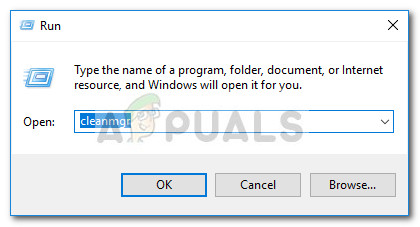
- In the Disk Cleanup window, select the Deejay Cleanup tab and check the box associated with Previous Windows installation(southward).
 Annotation: Yous can also bank check other entries if y'all're severely struggling to open up new free infinite.
Annotation: Yous can also bank check other entries if y'all're severely struggling to open up new free infinite. - Hit Ok to commencement the cleanup process and wait until it'due south completed. Next, return to the location of Windows.old ( it'due south in C:\ by default) and meet if the folder has been removed. If it still has some leftover files, right-click on it and choose Delete to remove it.
In example this method was not applicable, move over to Method 2.
Method 2: Deleting Windows.sometime from Storage settings
Some other fashion to delete the Windows.old binder without getting likewise technical is by using the Storage Settings. This method makes employ of the new and improved Windows x Settings wizard.
Here's a quick guide to deleting the Windows.old binder from the Storage settings:
- Press Windows fundamental + R to open up a Run command. In the Run command, type "ms-settings:storagesense" and striking Enter to open the Storage screen.
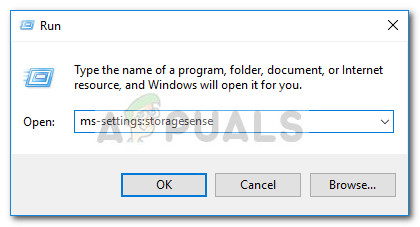
- On the correct side, click on your C bulldoze (or the drive letter that holds your Windows files).

- At the next screen, click on Temporary Files.

- Under Remove temporary files, check the box associated with Previous version of Windows, then click on Remove files.
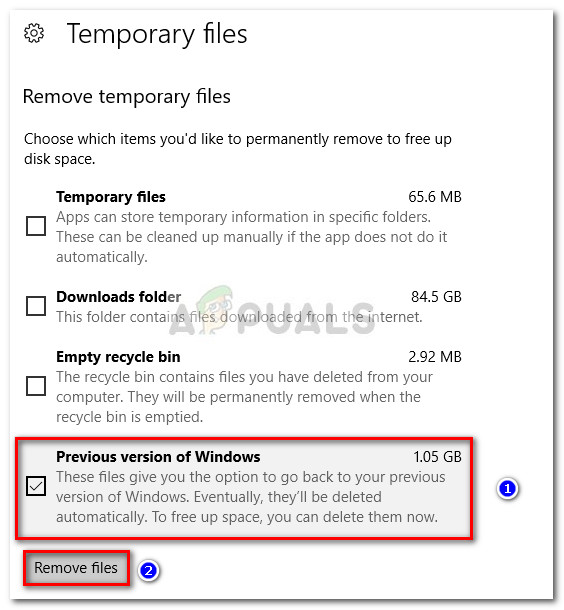
- Await until the procedure is finished, then you can safely close the Settings window. Finally, reboot your computer and encounter if the Windows.old folder is removed. If it isn't, move down to the methods below.
Method 3: Deleting the Windows.ord folder via Storage Sense
This is the final method that will permit you to remove the WIndows.quondam binder without getting technical. Only go on in mind that the Storage Sense settings will only get visible if you take Windows 10 build 16226 or older.
Here's a quick guide to using the Storage Sense settings to remove the Windows.old binder from your system:
- Printing Windows key + R to open up up a Run box. So, type "ms-settings:storagepolicies" and striking Enter to open up the Storage Sense settings.
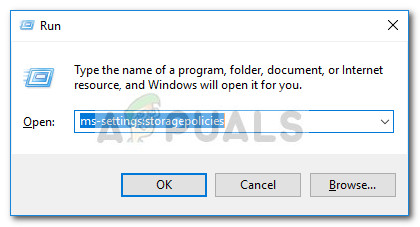
- In the Storage Sense settings, ringlet downwards to Free up space at present and check the box next to Delete previous versions of Windows.
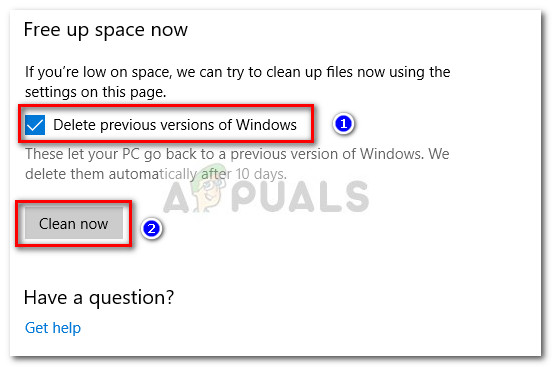
- Hit the Make clean at present button and expect for the process to complete. Once the procedure is consummate, reboot your PC and see whether the Windows.one-time folder has been removed.
If you're yet seeing the Windows.onetime folders and withal can't remove it past deleting information technology conventionally, move downwards to more than advanced ways of deleting it.
Method four: Deleting Windows.old folder later on claiming ownership
Most users that have been struggling with this issue for a while take finally managed to remove the Windows.old folder after claiming ownership of it.
Here's a quick guide on how to claim buying of the Windows.sometime binder in gild to be able to delete it:
- Right-click on the Windows.former folder and choose Properties.
- In Windows.onetime Properties, go to the Security tab and click on Avant-garde.
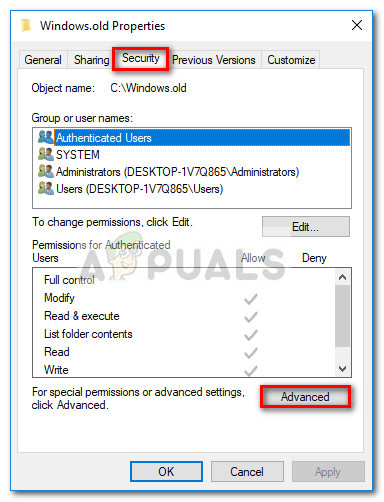
- Adjacent, striking the Change button on the newly appeared box.

- In the Select User or Grouping window, type "administrators", then click the Bank check Names button. One time the name has been identified, hit OK to shut the Select User or Group Window, then striking Apply at the Advanced Security Settings for Windows.old window.
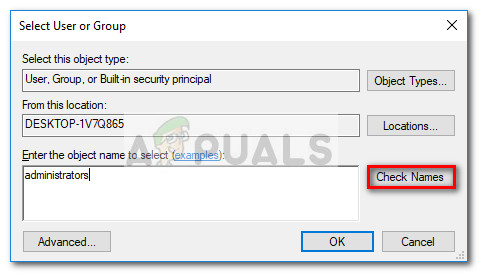
- Next, return to the Security tab and click the Edit push button. Then in the Permissions for Windows.old binder, check the Allow box associated with Full Control, then hit Apply.

- Now that yous took total ownership of the binder, y'all should be able to delete Windows.old conventionally. Only right-click on it and choose Delete or use the keyboard push button.
If you're still prevented from deleting the folder, move down to side by side method.
Method v: Deleting Windows.former in an Elevated Command Prompt
This method involves using an elevated command prompt in order to delete the windows.old folder with administrative privileges. Although information technology requires a sure caste of technical knowledge, the steps below tin can be followed quite easily and a result is extremely probable.
Here's a quick guide to opening an elevated control prompt and using information technology to delete windows.old:
- Acess the Start card and search for "cmd". And then, correct-click on Command Prompt and choose Run every bit Ambassador.

- In the elevated Command Prompt, type or copy the following commands and press Enter subsequently each one:
takeown /F "C:\Windows.old" /A /R /D Y
icacls "C:\Windows.onetime" /grant *S-1-5-32-544:F /T /C /Q
RD /South /Q "C:\Windows.quondam"
 Note:Keep in mind that if you have a different Bone bulldoze, you lot'll need to replace the "C" from the commands above with the right alphabetic character.
Note:Keep in mind that if you have a different Bone bulldoze, you lot'll need to replace the "C" from the commands above with the right alphabetic character. - One time all commands have been properly introduced and practical, you can safely close the elevated control prompt. See whether the method has been successful by seeing if Windows.one-time has been removed.
If the method wasn't successful in removing the Windows.one-time folder or if you got an error after inserting the last command, move over to the Method below.
Method six: Deleting Windows.one-time Folder from Advanced Options
If an elevated command prompt wasn't enough to larn the necessary permissions to delete the Windows.quondam folder, using a Command Prompt at boot might simply do the trick.
In club to follow the steps below, follow this guide (here) to access the Avant-garde Options of Windows 10, then click on Control Prompt.

Once you've successfully entered Command Prompt during kicking, follow the steps below to delete the Windows.old folder:
- In the Control Prompt window, type the following control and printing Enter to use information technology:
RD /S /Q "C:\Windows.old"
 Notation: Call up to replace the letter "C" with a different i if you take a custom location for your OS.
Notation: Call up to replace the letter "C" with a different i if you take a custom location for your OS. - Once the command has been successfully practical, close the Command Prompt and hit Continueto kickoff your operating arrangement unremarkably. Once the startup is complete, navigate to the location of windows.old and run into if it's at present removed.
If this method wasn't constructive, almost likely the deletion is prevented by a badly written driver. In such a case, the user has little option but to wait for the i month period to pass when Windows will automatically remove the Windows.quondam folder.
Source: https://appuals.com/how-to-delete-the-windows-old-folder-on-windows-10/
Posted by: darbyacend1994.blogspot.com

0 Response to "How To Get System Permission To Delete Windows Old"
Post a Comment